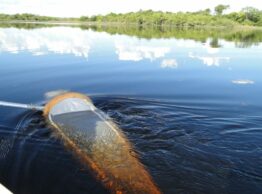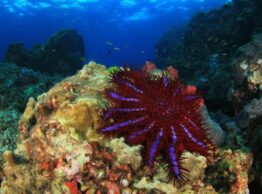Hands-On Activities
Check out the activities below to bridge the material covered in TinySea with activities students can experience first-hand!

Materials
- Plankton net and collection bottle
- Microscope(s)
- Microscope slides
- Transfer pipette
- Plankton identification sheet (see PDF version)
- Student packet (see PDF version)
Plankton Identification
Aims
This experiment allows students to gain tactile and visual experience with aquatic organisms and helps them understand the importance of the lowest trophic level. Explain to students that these zooplankton coincide with the level 1 organisms in the game. Remark how many zooplankton (both in type and in total) exist in the bottle of water that was gathered.
Directions
(check PDF for extended directions)
01
Tow plankton net by hand in a natural body of water. The fine mesh strains tiny zooplankton into the bottle at the end of the net.
02
Use the pipette to transfer specimens to microscope slides and put them under your microscope.
03
Using the Plankton Identification Sheet, identify what you found!

Materials
- Seastar pictorial cards
- Student packet (see PDF version)
Aims
This game introduces the concept of resource availability and resource scarcity to the students. The groups will likely consist of a different number of students each turn, which showcases the variability of populations with variations in ecosystem resources. This can be used to explain the importance of lower trophic levels for the survival of sea stars, and sea stars for the survival of higher trophic levels.
Human Ecosystem Game
Directions
01
Students are separated into 3 groups. Group 1 signifies crown of thorns sea stars, while groups 2 and 3 signify ecosystem components. These components are food, space, shelter and oxygen.
02
At the beginning of each round, groups 1, 2 and 3 gather into positions in which they cannot see the other groups. Group 1 chooses what resource they want to spend the turn looking for. They will indicate this with a specific hand signal when the turn starts. The signals are one finger for food, two fingers for shelter, three fingers for space and four fingers for oxygen.
03
Groups 2 and 3 will simultaneously choose which ecosystem components they choose to be for that round. They utilize the same hand signals to signify their chosen resource.
04
When the round starts, the students display their signals and face each other. Group 1 searches for ecosystem resources that match the one they’re looking for and brings them back to the sea star area. For the next round, this individual will function as a sea star for the next round. This represents the reproduction of the sea star during times with adequate resources. A sea star that doesn’t find the desired resource ‘dies’, and turns into an ecosystem resource for the next round.
05
Play 10 to 15 rounds, keeping track of the number of sea stars at the beginning for each round.
06
To further complicate the game, other factors can be introduced into the game, such as pollution or harmful temperature increases. Indicate these sudden disturbances by limiting the types of ecosystem resources available during that turn without telling the sea star group.
07
Following the game, discuss how many sea stars were available in each round and the effect each disturbance had. Additionally, discuss the impact of resource availability on survival of species and the importance of multiple trophic levels of species to maintain the healthy ecosystem with sea stars in it.
Web of Life
Directions
01
Pick an ecosystem that your students are familiar with and have students should think about the different organisms in that ecosystem.
02
Each student will pick a different organism in that ecosystem. Students should choose a wide range of organisms. A coral reef example might include algae, parrotfish, corals, sharks, turtles, sponges, jellyfish…
03
Discuss in small groups or all together how each of these organisms interact with each other.
04
Standing in a circle, give one student a ball of yarn. Have them pass it to a different organism that they interact with, while still holding on to the end of the yarn. Continue until every student is in the “ecosystem.”
05
Each student should pull their piece of yarn tight and observe how it is all connected in the center.
Aims
This activity demonstrates the interconnectedness of ecosystems and shows students that no organism operates on its own. Each organism plays a role in an ecosystem to help keep it balanced and healthy. If one were to be removed, several would be affected.
Materials
- Ball of yarn
This activity was adapted from Project Learning Tree’s “STEM: Web Of Life” at https://www.plt.org/stem-strategies/web-of-life/
